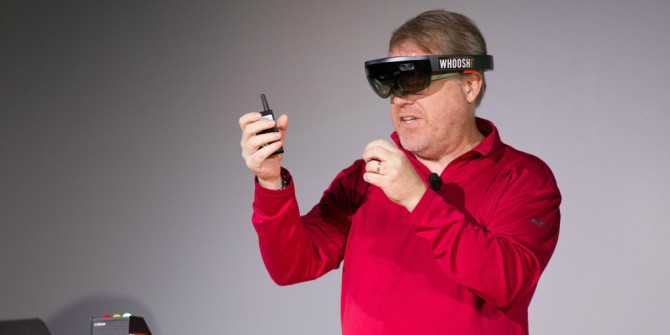
Piaggio Fast Forward is the autonomous vehicle arm of the Piaggio Group, creator of the iconic Italian Vespa motorcycle. Even though PFF dreams of one day helping to move people, its focus now is on helping carry heavy packages for short distances, such as grocery bags from the store around the corner to your doorstep. ‘Autonomous cars are just one piece of a much larger equation; we talk a lot about making vehicles for the right task and at the right scale,’ says Sasha Hoffman, chief operating officer of PFF. She spoke with LSE Business Review managing editor Helena Vieira during a tech conference in New Orleans in early May. The company’s first product, a round robot named Gita, is now in the pilot stage (check video below).
Gita is an Italian name, isn’t it?
It is. Gita means a short hop in Italian and what’s so great about it, we chose the name because Gita makes a bunch of little trips.
How would you define it? An autonomous suitcase, a minicar?
I call it a cargo-carrying vehicle and in many ways a lot of people compare it to separating your trunk from your car, and having that being able to follow you. It goes the speed of 0 to 22 miles an hour, so it’s fully functional at human speed, whether walking, biking, running, crawling, all of these speeds Gita can do.
Oh, it can follow you on your bike too…
Yes. When we were initially creating Gita a major point for us was to make sure it moved the same way a human did at human speeds. The real exception is when a human gets on a car. But pretty much outside that Gita can keep up with – any mode of exercise or medium of moving that you’re doing .
Can it climb stairs?
It cannot. It can go indoors and outdoors, on an elevator, up and down Americans with Disabilities Act (ADA)-compliant ramps, but it doesn’t climb stairs. Have you seen the shape? It’s a little bit more spherical in nature, so it can’t climb stairs.
Have you thought of it as a suitcase? It’s the first use that come to my mind…
I don’t think about it so much as a suitcase replacement. We think about it as extending someone’s mobility. Before, and we love to give this example of when this was originally ‘concepted’, how we came up with a size… I don’t know if you’ve seen any pictures of it with the lid open. A Gita on the inside can hold the equivalent of 15 wine bottles. When we first started doing some research, we asked ourselves the question, ‘When you go to the grocery store, and you live four blocks away, what is the point at which you take the car versus walking?’ The truth is, it’s not a gallon of milk, not even a bag of apples, it’s the second you find out you need to carry something that is the amount of weight of a case of wine, or something equivalent to that. Nobody wants to carry that even two blocks to the parking lot. We all use the shopping cart.
The idea was to have Gita work as a cargo bin both in terms of its size and how much it can hold. It should be big enough to hold something such as a case of wine or heavier. That was the threshold that we thought about clearing. And in most of the situations right now we use this for business applications… following around maintenance staff in office buildings, last-mile grocery delivering… In the current stage, it’s all enterprise applications. One day we really hope to sell it to the consumer, possibly in a different manifestation than it’s currently in, but it would be nice if we all had the ability to free our hands and have something that carried all of our belongings for us… I think we’ve all been that person at the airport, or a theme-park with your children, and you’re holding 20 different bags and it’s just uncomfortable. Gita is something intelligent that does the job and follows you, so you can be left to do more important tasks.
Behind Gita, there’s the concept of personal mobility. What are the trends in personal mobility that you’re looking at?
The biggest one everyone is talking about is what’s happening in autonomous cars, right? But the truth is autonomous cars are really one piece of a much larger equation. So when you’re looking at the future city, in order to actually be efficient, we talk a lot about making vehicles for the right task and at the right scale. There’s no reason if you’re going five blocks, and it’s just you by yourself, or you’re delivering a pizza, that you need an entire vehicle to do that. Sometimes, when I get stuff delivered to my house I feel bad unless it came on a bike, because cars add to the congestion problem that was already going on in my city.
I think about what’s happening now in terms of on-demand apps, infrastructure and systems that are putting so much pressure on our transportation system. The only way we can really keep up is to introduce vehicles that are appropriate for the right type of task, under the right size for that type of equation. You see a ton happening a lot more in the sharing economy overall, which I think is really pivotal to what is happening. You’re seeing so many changes that… I think the biggest things to come haven’t even been invented yet. We’re starting to hear about things like flying cars and more ground movement and ground delivery.
You might think flying cars are kind of a joke, but for me they simulate what’s actually coming which is new, completely different forms of mobility that we aren’t thinking about yet. There are a lot of people working on what I’m going to call last-mile commuting, this idea of going from your house to the train station, or from the station to your office, that short distance, thinking about things that are compact and that can go with you like a rolling suitcase, into a meeting.
We did a lot of surveying in the beginning of this company to understand why women didn’t want to ride bikes and one of the issues is that they didn’t want to lock it. They found it really annoying to be carrying around a lock, lock the thing, find space for it, it was just really cumbersome. Can you make new, simpler objects that are much easier for people to actually use? As we speak, there’s a ton of advancement being made just in public transportation in general. Public transportation is never going to be replaced by autonomous cars. And if you simply go and replace every car today with an autonomous car, your congestion problems do not disappear at all. And in some ways, they actually get worse, because these cars are constantly on the road and if they belong to me personally, versus being part of a shared ecosystem, they’re not being used efficiently.
There’s a lot happening in terms of additional bikes, two- and three-wheeled forms of light weight mobility. And then there are things like what we’re doing, which is trying to better move goods and separating the idea of moving people and moving goods and using goods-based delivery systems, when all you have to do is move a pizza, or move a wine box, or move something else. So, that’s part of the equation that we’re in.
Is Gita your only product right now?
Gita has an older brother called Kilo. Kilo has the exact same functionality but it holds 250 pounds. That one is an earlier-stage prototype. We’re trying to catch them up to the same thing. You can imagine many more instances like airports where you need to hold heavy pieces of luggage. Those are the types of instances where a Kilo is very helpful.
What is the logical next step for Piaggio Fast Forward? What other kinds of products are in the pipeline?
They’re a while away, so I’m not going to promise any time soon, but we would love to transport humans at some point. Piaggio is a 134-year old company that has outfitted planes, ships, scooters, motorcycles. They’re a company that moves humans. We definitely have a desire to rethink about a two or three-wheeled vehicle that keeps somebody’s hands free. This is one of our core values in the company, that we build products that enable people to just use their hands for more intelligent tasks, so whatever we end up building would be a core component of that and you can use other things on your body that can actually help move a vehicle. We will not make a scooter, we will not make a motorcycle, we will not make a car. We can say that with 100% confidence. We looked at some early designs of things that we’re interested in as those continue to evolve, as we ramp up Gita and Kilo at some point we’ll certainly go back to the drawing board and look into moving humans – or something that moves humans and goods.
Are people or businesses going to own or rent Gita, how will it be marketed?
It’s a great question. We’re still answering some of those questions. We’ve just launched in February. We’re going to be piloting throughout the rest of the year with an assortment of businesses in different industries. Before we go into manufacturing, towards the end of the year or beginning of next year, one of the things we’re figuring out now is ‘does it make sense to really sell this as an individual product or to actually lease fleets potentially?’ We’re big believers in the sharing economy. There will potentially be a situation similar to bike sharing. Maybe there’s a Gita station in the middle of your city, positioned in places where you’ll be picking up a lot of goods, whether that be near grocery stores or shopping areas, so you can use Gita to go home within a certain radius. And then Gita would autonomously get back to base, meaning the charging station. Those are the types of things that we’re looking at and seeing which of them make sense. We want to be able to reduce the congestion problem. If everybody owns their personal robot, that’s just adding to what’s on the street. I think that we’re looking at ways to help this be shareable amongst different people.
Gita is an electrical vehicle, right?
Yes, it uses a lithium-ion battery.
Your tagline, ‘Autonomy for humans’, is that related to freeing our hands?
Yes, it’s really related to that. We, as humans, are obviously autonomous, but this idea of saying ‘Can you create a class of vehicles that really just enables humans to do more? Can you enable them to move better, faster, further? We want people to exercise more. We want people to actually get out. So often people just default to taking the car or taking public transport, but if you knew that walking was an option and the reason you didn’t do it was because you had to carry too much stuff, maybe now this actually introduces an option for you to walk more and to do more. That really is our goal. It’s creating vehicles that just allow people to be more autonomous on a consistent basis.
That all depends also on the quality of our sidewalks…
Of course. And if you’ve ever seen the cobblestones in Boston, you can imagine what it’s like to test our vehicles on the sidewalks. If they can manage that, they’ll probably do pretty well in most places.
You’ve ruled out self driving cars?
It’s a busy space. At the end of the day, a self driving car is not a hardware problem, it’s a software problem. And so the people who are software tech giants are the ones who are best positioned to really tackle those problems, you know, Apple is now testing a few self driving cars, you have Tesla, you have google, nuTonomy, I can name you all the companies, everyone is looking to get into this business. But the people who are better positioned to do this are in fact those who are solving all the software problems. You can put that system on any car. At the end of the day you can put it on any hardware, as long as that other configuration works. But if the software doesn’t work, the product doesn’t work. Period. Doesn’t matter whose car it’s on.
You mentioned before the need to break down problems…
I was saying in breaking down problems, you see the introduction of new forms of these types of mobility that you haven’t heard about before, because people are just completely reassessing the problem. Which is the same thing we did. We went and said, ‘what’s the future city going to look like?’ ‘what are all the problems today?’ You’re sort of solving problems in the future you don’t even know about as we evolve. And we try to just break down the equation. We say, ‘let’s stop trying to solve everything, let’s just get one of these things really right, which was moving goods in certain environments, indoors and outdoors, at human speeds. That’s one part of the problem. Cars are going to solve a different part of the problem. And what appears to be a crowded space to me in many ways has a ton of opportunity. If you start to get people siloing what they can actually solve as part of the larger ecosystem, I think a lot more gets done.
I read about how integration is really important for social mobility, so maybe you’ll have to convince bus services in the Boston area to create Gita cargo areas…
All of these things integrate, right? Also street lights. And being able to share the data that an autonomous car has with everything around it. There’s a simulation that MIT sensible lab made and it was all these autonomous cars going through an intersection that had no street lights and it was efficient because they were all talking to each other. But if all these car companies go and don’t work on systems that everyone can understand, like information system, and there’s something they’re not open about and we have a problem because we’re just creating things where nobody’s vehicles can talk to each other. That doesn’t help with the efficiency problem.
So the industry has to come together…
Yes, and you’re telling a bunch of your competitors, please come together, and share. It’s much easier said than done.
Watch this video produced by Endgadget:
♣♣♣
- This Q&A is the tenth in a series of 11 interviews with tech leaders during the Collision conference in New Orleans, 2-4 May 2017.
- The post gives the views of the interviewee, not the position of LSE Business Review or of the London School of Economics and Political Science.
- Before commenting, please read our Comment Policy.





